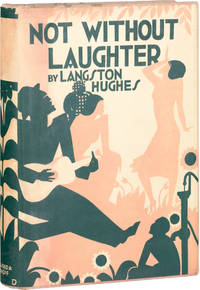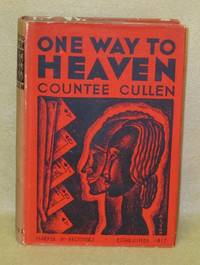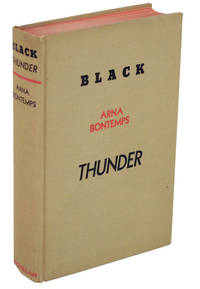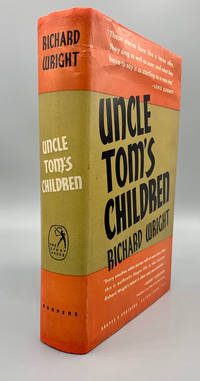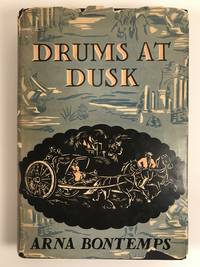African American Literature 1930-1939
-
Not Without Laughter by Langston Hughes
Not without Laughter was the debut novel of Langston Hughes, who after published two poetry collections, The Weary Blues (1926) and Fine Clothes to the Jew (1927), had cemented his reputation as a literary voice of his generation while still in his twenties.
The novel portrays black life in the early 20th century through Sandy Rogers, a young black boy growing up in a small mostly white Kansas town. Sandy grows from boy to man surrounded by family: His mother, Anjee, works as a housekeeper for a wealthy white family, his father is a traveling musician, his grandmother is strong-willed and bound by religious conviction, and his Aunt Harriet has dreams of singing the blues. Against the backdrop of this rural American town, the racial differences and struggles are highlighted, along with the family’s joy and love.
The dust jacket of the original first edition, published by Alfred A. Knopf in 1930, was designed by the Harlem Renaissance artist Aaron Douglas, who, like Hughes, grew up in Kansas.
-
Black No More by George Schulyer
Schuyler's very scarce first novel, Black No More, is a satire on Race Relations in the United States, in which a black scientist discovers a serum that changes black skin to white. As people choose to ‘whiten’ their skin for various economic and social reasons, the importance of racial segregation to maintain white economic and social status becomes more apparent. Considered the first ‘Afrofuturism’ novel due to science fiction details in the novel. Schuyler takes aim at not only the KKK but the NAACP and the leaders of the ‘talented tenth’ - some by name, some in thinly veiled caricatures.
The first edition of Black No More was published in 1931 by The Macaulay Company. There was only one printing of the first 1930s edition, but multiple reprints, in 1968, 1971, 1989, and 1999 have been done.
-
One Way to Heaven by Countee Cullen
The novel One Way to Heaven was a social comedy about life in Harlem. Author Countee Cullen was a prominent figure in the Harlem Renaissance. His poetry was highly celebrated, starting with his first book Color (1925), then Copper Sun (1927), and The Black Christ & Other Poems (1929). His wedding to Yolande DuBois, the daughter of scholar WEB DuBois, was the event of the decade in 1920s New York.
One Way to Heaven, Cullen’s only novel, was first published by Harper and Brothers, New York, in 1932.
-
Jonah's Gourd Vine by Zora Neale Hurston
Jonah's Gourd Vine was the debut novel of Harlem Renaissance writer Zora Neale Hurston. The novel revolves around John Pearson, a preacher in a small black town in Southern Florida that was modeled on where Hurston herself grew up. Although the preacher loves his wife, he loves other women as well, highlighting the constant human struggle between the spiritual and the physical. The biblically-based title is reflected in the life and position of Pearson as the 'gourd vine', and his weaknesses and destructive tendencies as the worm that destroyed the plant.
Hurston reportedly wrote the novel in just three or four months. The first edition of Jonah's Gourd Vine was published by J.B. Lippincott Company, Philadelphia in 1934.
-
Ollie Miss by George Wylie Henderson
Ollie Miss was the first novel by author George Wylie Henderson. In it, a young black woman seeks happiness and independence in the rural backwoods of Alabama. Henderson followed Ollie Miss with a sequel, Jule - advertised as “Alabama Boy in Harlem,” about the illegitimate son of Ollie who moves to Harlem. The characters in Henderson’s book follow patterns of his own life, growing up in the rural South then joining the Great Migration to the Urban north.
The first edition of Ollie Miss was published by Frederick A. Stokes, New York, in 1935. Illustrated with block cuts by Lowell Leroy Balcom.
-
Black Thunder by Arna Bontemps
Born in 1902 in Louisiana, Arna Bontemps was a poet, novelist, and librarian, as well as a noted member of the Harlem Renaissance. Bontemps served as head librarian at Fisk University from 1969 to 1972. He was also curator of the James Weldon Johnson Memorial Collection of Negro Arts and Letters at Yale University. He is credited with writing over 20 books, plays, and anthologies.
The novel Black Thunder, by Arna Bontemps, is considered one of his best works. It is the fictional retelling of a slave insurrection led by Gabriel Prosser in Virginia in 1800. Black Thunder was first published by The MacMillan Company, New York, in 1936.
-
Uncle Tom's Children by Richard Wright
Uncle Tom's Children is a collection of novellas and the first book published by African-American author Richard Wright, who went on to write many other works including Native Son (1940), Black Boy (1945), and The Outsider (1953).
The four novellas included in the first edition of Uncle Tom's Children were "Big Boy Leaves Home," "Down by the Riverside," "Long Black Song," and "Fire and Cloud." In 1940 Uncle Tom's Children was published with an additional two novellas, the first and last added - "The Ethics of Living Jim Crow" and "Bright and Morning Star". The first edition of this novel was published by Harper & Brothers, New York, in 1938.
-
Drums at Dusk by Arna Bontemps
Drums at Dusk by Arna Bontemps is set on the island of San Domingo (now Haiti) in 1791. The story is a widely-recognized fictional retelling of Toissant L'Overture and the slave revolt on the island. The novel’s hero, Diron Desautels is a white creole who belongs to a French anti-slavery group. The novel shows how Caribbean history influenced the Southern United States, and it inspires a reevaluation of assumptions about revolution, race, and nationalism.
The first edition Drums at Dusk was published by The MacMillan Company, New York in 1939.
Subscribe
Sign up for our newsletter and receive coupons via email.

Author Bio: Amy C. Manikowski is a writer, bookseller, trail-diverger, history buff, and pitbull lover. She graduated from Chatham University with an MFA a while ago, and after wandering aimlessly settled in Asheville NC.
